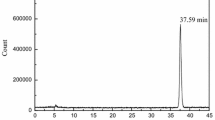Abstract
To determine the effects of tellurium-heteroatom position on myocardial fatty-acid kinetics, a series of tellurium Te 123m-labeled heptadecanoic-acid analogs (123mTe-THDA) were evaluated in dogs. The left-anterior descending coronary artery was partially occluded, and 123mTe-THDA labeled at either the 5, 6, 9, 10, 11, 12 or 13 position from the carboxyl group was administered intravenously. In 24 dogs, the 123mTe activity in the ischemic and normal zones was monitored continuously for 3 h using miniature radiation detectors. There were no significant differences between the ischemic- and normal-wall 123mTe clearance rates for any of the compounds. There was minimal fractional 3-h myocardial clearance for the 123mTe-THDA labeled at the 5, 6, and 9 position (range of means, 0.02–0.05). There was significant clearance of 123mTe-THDA labeled at the 11, 12, and 13 position (range of means, 0.37–0.44). The myocardial clearance of the 123mTe-THDA labeled at the 10 position was intermediate between the two extremes. Thus, as the 123mTe heteroatom is placed further from the carboxyl portion of the molecule, there is a progressive increase in the myocardial clearance. Selection of the heteroatom position should depend on whether initial fatty-acid distribution or subsequent clearance rates are being studied.
Similar content being viewed by others
References
Domenech RJ, Hoffman JIE, Noble MIN, Saunders KB, Henson JR, Subijanto S (1969) Total and regional coronary blood flow measured by radioactive microspheres in conscious and anesthetized dogs. Circ Res 25:581–596
Elmaleh DR, Knapp FF, Yasuda T, Coffey JL, Kopiwoda S, Okada RD, Strauss HW (1981) Myocardial imaging with 9-Te-123m-telluraheptadecanoic acid. J Nucl Med 22:994–999
Evans JR, Gunton RW, Baker RG, Beanlands DS, Spears JS (1965) Use of radioiodinated fatty-acid for photoscans of the heart. Circ Res 16:1–10
Freundlieb C, Hock A, Vyska K, Feinendegen LE, Machulla HJ, Stocklin G (1980) Myocardial imaging and metabolic studies with I-123 iodoheptadecanoic acid. J Nucl Med 21:1043–1050
Gewirtz H, Grotte GJ, Strauss HW, O'Keefe DD, Akins CW, Daggett WM, Pohost GM (1979) The influence of left ventricular volume and wall motion on myocardial images. Circulation 59:1172–1177
Goodman MM, Knapp FF (1983) A convenient synthesis of unsymmetrical organotellurides of biological interest. Organometallics 2:1106–1108
Hoffman EJ, Phelps ME, Weiss ES, Welch MJ, Coleman RE, Sobel BE, Ter-Pogossian MM (1977) Transaxial tomographic imaging of canine myocardium with C-11-palmitic acid. J Nucl Med 18:57–61
Jacobs ML, Okada RD, Daggett WM, Fowler BN, Strauss HW, Geffin G, Pohost M (1982) Regional myocardial radiotracer kinetics in dogs using miniature radiation detectors. Am J Physiol 242:H849-H854
Knapp FF, Ambrose KR, Callahan AP, Ferren LA, Grigsby RA, Irgolic KJ (1981) Effects of chain length and tellurium position on the myocardial uptake of Te-123m fatty-acids. J Nucl Med 22:988–993
Neely JR, Rovetto MJ, Ovam JF (1972) Myocardial utilization of carbohydrate and lipids. Prog Cardiovasc Dis 15:289–329
Okada RD, Knapp FF, Elmaleh DR, Yasuda T, Boucher CA, Strauss HW (1982) Tellurium-123m-labeled-9-telluraheptadecanoic acid: A possible cardiac imaging agent. Circulation 65:305–310
Poe ND, Robinson GD, MacDonald NS (1975) Myocardial extraction of labeled long chain fatty acid analogs. Proc Soc Exp Biol Med 148:215–218
Poe ND, Robinson GD, Graham LS, MacDonald NS (1976) Experimental basis for myocardial imaging with I-123 labeled hexadrecenoic acid. J Nucl Med 17:1077–1082
Sobel BE, Weiss ES, Welch M, Siegel BA, Ter-Pogossian MM (1977) Detection of remote myocardial infarction in patients with positron emission tomography and intravenous C-11-palmitate. Circulation 55:853–857
Strauss HW, Elmaleh D, Knapp FF, Goodman D, Okada R, Barlai-Kovach M, Murphy J, Varnum D, Lutrario D (1982) Relationship of modified fatty-acid uptake in the myocardium to heteroatom position in the molecule. Circulation 66:109
van der Wal EE, Westera G, den Hollander W, Visser GC (1981) External detection of regional myocardial metabolism with radioiodinated hexadecenoic acid in the dog heart. Eur J Nucl Med 6:147–151
Weiss ES, Hoffman EJ, Phelps ME, Welch MJ, Henry PD, Ter-Pogossian MM, Sobel BE (1976) External detection and visualization of myocardial ischemia with C-11-substrates in vitro and in vivo. Circ Res 39:24–32
Author information
Authors and Affiliations
Additional information
Dr. Okada is an Established Investigator of the American Heart Assocition, Dallas, Texas, USA
Rights and permissions
About this article
Cite this article
Okada, R.D., Knapp, F.F., Goodman, M.M. et al. Tellurium-labeled fatty-acid analogs: Relationship of heteroatom position to myocardial kinetics. Eur J Nucl Med 11, 156–161 (1985). https://doi.org/10.1007/BF00251366
Received:
Issue Date:
DOI: https://doi.org/10.1007/BF00251366




